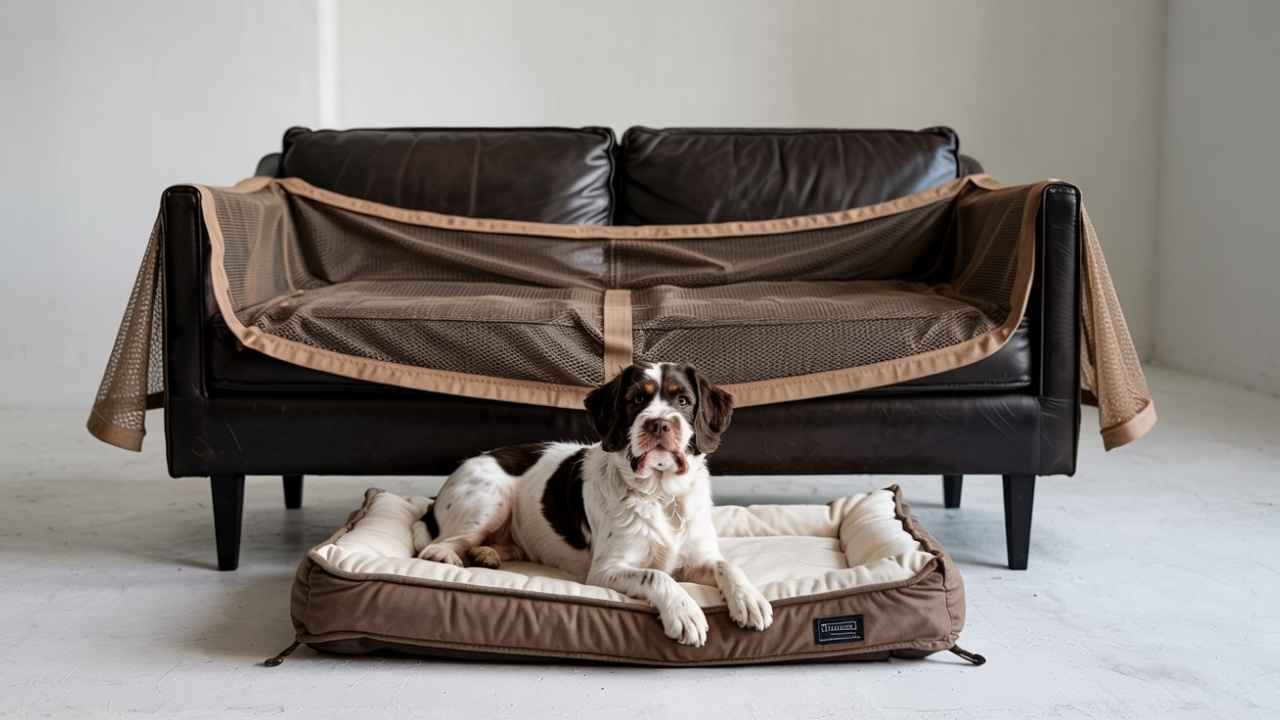Many dog owners love sharing their homes with their pets, but not everyone wants to share their furniture. Some prefer a no-couch policy to keep their space clean, organized, and free from damage.
There are several reasons why people choose to keep dogs off the couch. The most common reason is hygiene—dogs bring in fur, mud, and debris, which can make couches dirty fast. Others worry about dog slobber, scratches from claws, or the smell that can linger on soft fabrics. Some pet parents also want to prolong furniture lifespan, especially if they’ve invested in expensive sofas.
Another big reason is training consistency. Letting your dog on the couch sometimes and not other times can confuse them. Consistent rules help your dog understand boundaries and what is expected in the home.
If your dog has claimed your couch as their throne, don’t worry—there’s a solution. With simple steps, some positive reinforcement, and a little patience, you can teach your dog to enjoy their own cozy bed and leave your couch alone.
🛋️Why Dogs Love the Couch
Before setting rules, it helps to understand why dogs are so drawn to the couch in the first place. This insight makes dog behavior training more effective and compassionate.
Warmth and Comfort
Couches are soft, padded, and warm—just like a perfect dog bed. Dogs enjoy the support and softness that reminds them of cuddling with their littermates or resting in cozy spots. A couch offers comfort that many floors or harder beds can’t provide.
Height Advantage
Being higher up gives dogs a better view of their surroundings. From the couch, they can watch out the window or keep an eye on their family. This is part of their elevation preference, and it makes them feel more included and alert.
Smells Like You
Your couch smells like you and your family. Dogs love being close to your scent—it makes them feel safe and connected. This is especially true for dogs that struggle with separation anxiety or are very bonded with their humans.
Habit or Routine
Dogs are creatures of habit. If your dog has been allowed on the couch in the past, they see it as their normal resting spot. Breaking this habit will take time, clear boundaries, and lots of encouragement to choose a better alternative.
Understanding these reasons will help you choose the right dog-friendly alternatives and training methods. With the right approach, you can make the couch less appealing and guide your dog to a designated spot that’s just as cozy.
🛋️Should You Let Dogs on the Couch?
Letting dogs on furniture is a personal choice. Some pet owners love snuggling with their dogs on the sofa, while others prefer a no-couch policy. Before deciding, it’s important to look at the pros and cons.
✅ Pros:
- Comfort and bonding: Dogs enjoy being close to you. It helps strengthen the human-animal bond.
- Security: Some dogs feel safer when they’re near their owners.
- Warmth: The couch is soft and warm, offering comfort, especially for senior dogs or those with arthritis.
❌ Cons:
- Hair and dirt on furniture: Dogs bring in fur, mud, and other debris.
- Furniture damage: Scratches, biting, and slobber can ruin cushions.
- Health concerns: Dogs might carry allergens or germs that stay on your couch.
- Training issues: Letting dogs on the couch sometimes but not always can confuse them.
Think about your dog’s size, breed, and personality. Large dogs take up more space and can cause more wear. Small breeds may jump up easily, but they can hurt their backs, especially on high furniture. Puppies may learn the habit early, while older dogs may be harder to retrain.
It’s also good to understand dog behavior. Some believe letting dogs on the couch makes them “dominant.” This is a myth. Dogs aren’t trying to take over—they just want comfort and closeness. Instead of fear-based rules, focus on positive reinforcement and teaching boundaries with kindness.
🐶How to Keep Dogs Off the Couch — Step-by-Step
If you’ve decided to keep your couch dog-free, follow these simple and effective methods.
Set Clear Boundaries
Dogs need clear and consistent rules. Start boundary training early—puppies are more impressionable. But older dogs can also learn with patience.
- Be consistent. Every family member should follow the same rule. If one person lets the dog on the couch, it will confuse the dog.
- Teach your dog that the couch is an off-limits area using calm guidance, not punishment.
Provide an Appealing Alternative
Give your dog a better place to relax so they’re less interested in the couch.
- Set up a comfortable dog bed or mat near where your family spends time.
- Dogs like to be close to their people, so don’t put their bed in a faraway room.
- Use high-value treats, dog toys, or their favorite blanket to make the new spot enjoyable.
- This “designated spot” can become your dog’s safe, happy place.
Use Positive Reinforcement
Reward good behavior instead of punishing bad behavior.
- When your dog chooses their bed instead of the couch, give them a treat.
- You can use clicker training to mark the exact moment they do the right thing.
- Timing is important. Reward quickly so your dog links the action with the treat.
Use Deterrents (Humane Options)
Make the couch less appealing without scaring or hurting your dog.
- Try couch deterrents like aluminum foil or crinkly plastic.
- Use pet-safe sprays with scents dogs dislike.
- Use products like X-Mats, Couch Defenders, or place plastic mats or furniture covers on the couch.
- These tools work as physical barriers and change the texture of the couch.
Block Access When Unsupervised
If you’re not home, your dog may still sneak onto the couch. Try these tricks:
- Use baby gates, dog gates, or closed doors to restrict access.
- Remove or prop up cushions so the couch is uncomfortable.
- Try crate training or let them rest in a dog pen when unsupervised.
- Use dog-proof couch methods to keep the furniture safe while you’re out.
Train “Off” and “Place” Commands
Teaching your dog basic command training helps you manage their behavior.
“Off” Command:
- When your dog is on the couch, say “off” in a calm voice.
- Lure them off with a treat and praise them when all four paws touch the ground.
- Never push or yell—avoid physical interventions.
“Place” Command:
- Choose a cozy bed or mat as the “place.”
- Say “place” and lead your dog there with a treat.
- When they lie down, reward them.
- Practice daily so they understand this cue means it’s time to relax in their own spot.
❌What to Avoid
When teaching your dog to stay off the couch, it’s just as important to know what not to do. These common mistakes can slow down training or create unwanted behaviors.
Yelling or Using Physical Punishment
Avoid shouting or pushing your dog off the furniture. These actions may cause fear, confusion, or even defensive biting. Dogs don’t understand punishment after the fact. Instead of learning what not to do, they may just feel scared or anxious.
Using positive reinforcement works better. Dogs respond well to rewards, not punishment. Always focus on reinforcing good behavior, like choosing their designated spot or dog bed.
Inconsistency
One of the biggest mistakes is being inconsistent. If your dog is allowed on the couch one day and scolded the next, they won’t understand the rules. All family members must follow the same training approach. Dog training consistency helps your pet learn faster and feel secure.
Stick to the same commands, offer rewards regularly, and keep the rules clear at all times.
Expecting Overnight Results
Dog behavior training takes time. Dogs form habits just like humans, and breaking those habits doesn’t happen in a day. Be patient and allow for gradual progress. Stick with your training methods and don’t give up if your dog has setbacks.
With regular practice, a good reward system, and lots of praise, your dog will learn to stay off the couch.
🛠️Troubleshooting Tips
Even with a solid plan, some dogs will test the limits. These tips can help you handle common problems along the way.
What If Your Dog Sneaks on the Couch Only When You’re Gone?
Some dogs become couch surfers when they think no one is watching. This is often a sign of habit, curiosity, or comfort-seeking.
- Set up cameras to check if your dog jumps on the furniture while you’re out. This helps you understand their routine.
- Try crate training or set up a dog pen when you leave the house.
- Use barriers like baby gates, dog gates, or couch deterrents (like aluminum foil, plastic mats, or X-Mats) to block access.
- Increase mental enrichment during the day. Offer puzzle toys, chews, or interactive playtime before leaving. A tired dog is less likely to misbehave.
What If Your Dog Is Anxious or Clingy?
Some dogs jump on the couch because they are anxious or too attached to their owner. This is common in dogs with separation anxiety or in rescue dogs.
- Focus on comfort-focused training. Create a cozy spot like a memory foam dog bed or orthopedic dog bed where they feel safe.
- Keep their alternative bed close to your favorite hangout area so they don’t feel left out.
- Gradually teach independence with command training, like “stay” or “place.”
- Use calm dog training methods and avoid fear-based training. You may also consider speaking with a dog behaviorist or certified behavior consultant if anxiety remains high.
🛋️When It’s Okay to Bend the Rules
There may be times when it’s okay to let your dog on the couch—especially in special situations. You don’t always have to be strict if it makes your dog more comfortable and happy.
Elderly Dogs and Medical Needs
Older dogs or dogs with health problems may find it hard to lie on the floor. A couch can give them extra support and warmth. Dogs with joint pain, arthritis, or injuries may need a soft surface. In these cases, it’s okay to let them use the couch if it helps them rest better.
You can also consider an orthopedic dog bed as a safer, lower option. These beds support their body and are easier to climb into than a couch.
Extreme Weather
During very cold or hot weather, dogs may seek out the couch for comfort. Cold floors can be harsh in winter, and your couch may feel much warmer. If this happens, you can allow couch time with proper protection.
Create “Allowed” Zones
If you decide to share your couch sometimes, create clear rules. Use a dog-friendly couch cover, washable blanket, or designated corner of the sofa. This teaches your dog that only certain spots are okay.
Use command training to help them understand where they can and can’t sit. Over time, they’ll learn to go straight to their allowed area.
Remember, it’s okay to adjust your rules based on your dog’s needs—as long as the rules stay clear and consistent.
🎯 Conclusion
Training your dog to stay off the couch takes patience, consistency, and positive reinforcement. Dogs don’t learn overnight, but with gentle guidance and rewards, they will understand what is expected.
Always consider your dog’s personality, breed, and lifestyle. A playful puppy may need different training than a senior dog. Some dogs are more stubborn, while others just want to be near you.
No matter what your situation is, there is always a way to teach your dog better behavior without fear or punishment.
With a little effort, your couch can be dog-free—and your dog just as happy.
You may also read: How to protect wall from dog during storm




